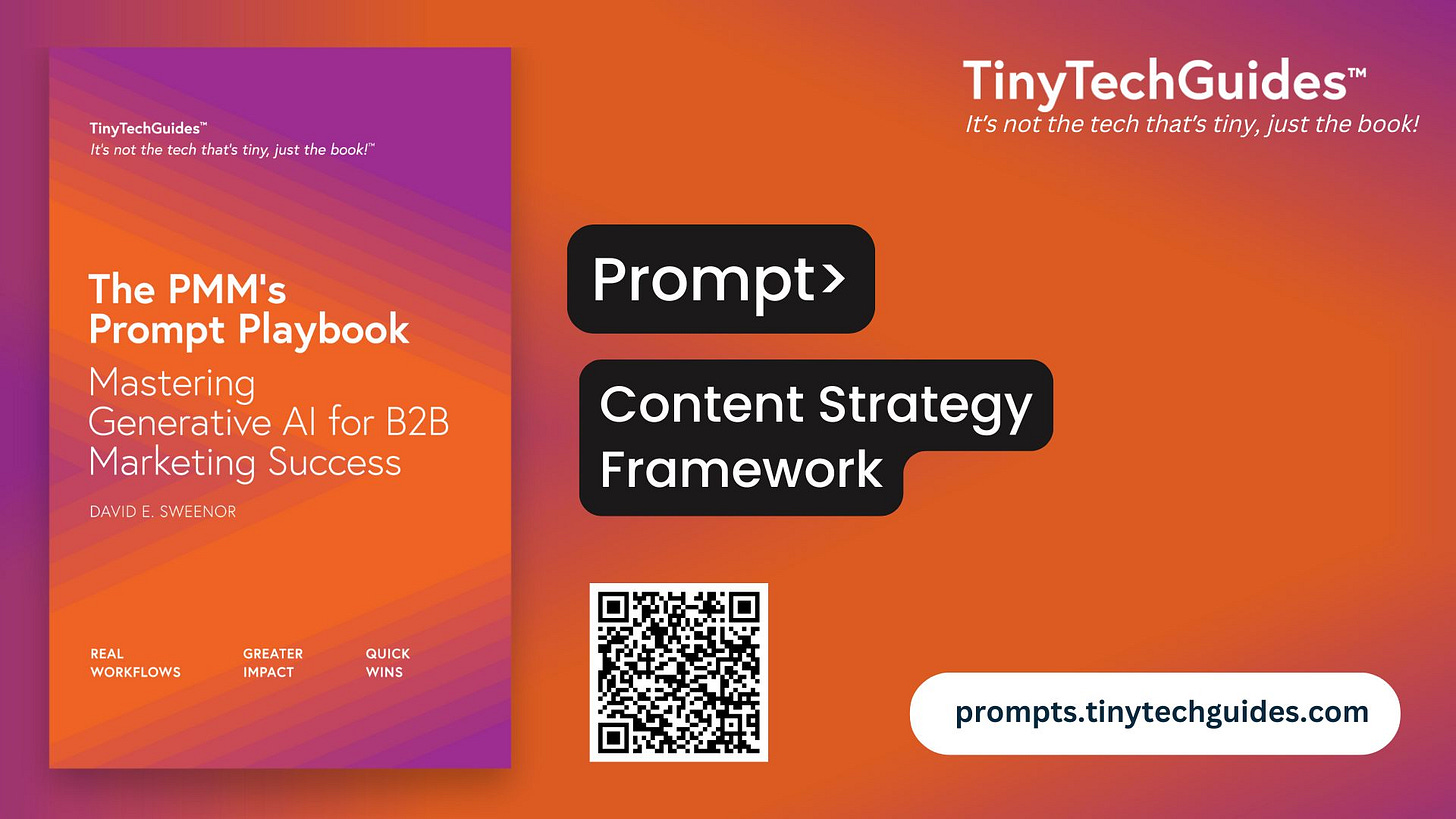Content Strategy Prompt Template for B2B Marketers
Create goal-driven, persona-aligned content plans that drive awareness, engagement, and sales.
Content Strategy Framework
This updated prompt is part of The PMM’s Prompt Playbook which has 30 ready-to-use prompts. If you're looking for more cut-and-paste prompts, join the Substack! Paid subscribers receive new cut-and-paste prompts every week.
Get the PMM’s Prompt Playbook and Modern B2B Marketing today!
What This Workflow Does
The Content Strategy Framework helps marketing teams create a focused, goal-driven content plan that speaks directly to their audience. It guides you step-by-step through defining business goals, understanding your buyers, crafting messaging, mapping content to the funnel, and planning execution. The result? A clear, repeatable system for producing high-impact content that supports lead generation, customer education, and brand growth.
Workflow Steps Summary
Step 0: Define inputs
Step 1: Define content goals
Step 2: Identify audience segments and content needs
Step 3: Develop content themes and messaging
Step 4: Map content types to the buyer journe
Step 5: Create a content calendar outline
Step 0: Define Inputs
{industry=Insert your target industry, e.g., enterprise cloud security.}
{solution=Insert your product/solution, e.g., AI-driven threat detection platform.}
{audience=Insert your target audience, e.g., CISOs, DevOps teams, IT security leaders.}
{goals=Insert your content goals, e.g., lead generation, brand awareness, customer education.}
Step 1: Define Content Goals
#Role
You are a content strategy expert specializing in {industry} and {solution}.
#Context
I need to create a content strategy that aligns with our business goals and resonates with {audience}. The strategy must focus on solving customer pain points, communicating product value, and guiding buyers through the decision-making process.
#Task
Develop a content strategy framework that includes:
- Goals
- Audience
- Content themes
- Content types
- Content calendar ideas
#Format
Goals:
- Goal 1: [Example]
- Goal 2: [Example]
Audience:
- Segment 1: [role]
- Needs: [content needs]
- Segment 2: [role]
- Needs: [content needs]
Content themes:
- Theme 1: [Example]
- Theme 2: [Example]
Content types:
- Top-of-funnel: Blog posts, social snippets, short videos
- Middle-of-funnel: Case studies, webinars, whitepapers
- Bottom-of-funnel: ROI calculators, comparison guides, product demos
Content calendar ideas:
- Awareness: [Blog title example]
- Consideration: [Webinar example]
- Decision: [ROI tool example]
#Tone
Strategic, structured, and actionable.
Step 2: Identify Audience Segments and Content Needs
#Role
You are a customer insights specialist analyzing content needs for {audience} in {industry}.
#Context
I need to understand the content preferences and pain points of our target audience to ensure the strategy addresses their needs effectively.
#Task
For each target audience segment:
- Identify key challenges related to {solution}
- Determine content preferences (formats, channels)
- Suggest relevant content topics
#Format
Audience Segment: [e.g., CISOs]
- Challenges: [...]
- Content preferences: [...]
- Content ideas:
- Topic 1: [...]
- Topic 2: [...]
#Tone
Audience-focused, clear, and practical.
Step 3: Develop Content Themes and Messaging
#Role
You are a messaging strategist defining key content themes and messages for {solution}.
#Context
To ensure content aligns with our product positioning and audience needs, I need to develop content themes and supporting messages.
#Task
Develop 3–5 content themes and supporting messages for each. Align with pain points and business outcomes.
#Format
Theme 1: [Example]
- Message 1: [...]
- Message 2: [...]
Theme 2: [Example]
- Message 1: [...]
- Message 2: [...]
#Tone
Clear, benefit-driven, and consistent.
Step 4: Map Content to the Buyer Journey



